Some gardens intrigue us with their beauty and individuality. This artist’s garden in Phoenix is one of those. The private garden surrounds old adobe structures in a historic district and belongs to Suzanne Bracker, who has filled it with bright splashes of color, unexpected whimsical repurposed items and pieces of her art that blend seamlessly with the surrounding plants. “My garden continues to evolve,” she says. “Every day in my garden is a new beginning.”
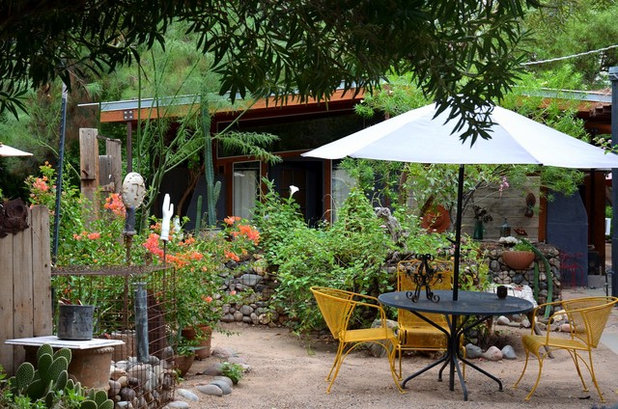
Noelle Johnson Landscape Consulting
Yard at a GlanceWho lives here: Suzanne Bracker
Location: Phoenix
Size: A half acre
A small historical district lies just a few blocks from downtown Phoenix, where small adobe homes dating from the 1930s sit on generously sized lots. Take a short walk down Flower Street, where an artist’s garden is waiting to reveal unexpected discoveries and scattered touches of whimsy.
Shown: Queen’s wreath vine (
Antigonon leptopus) trailing over gabion walls in the courtyard
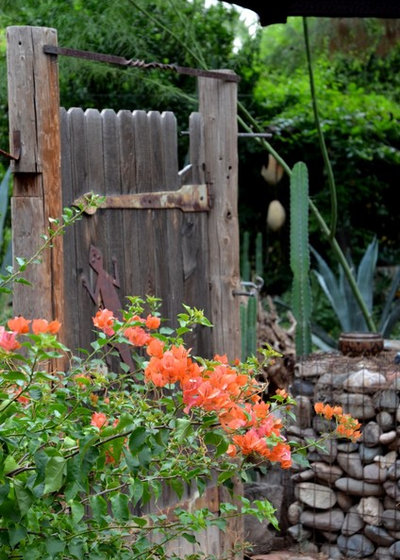
Noelle Johnson Landscape Consulting
Garden gates greet and beguile us as we imagine what lies beyond. A bougainvillea (
Bougainvillea sp.) shrub adds welcome color against the gate.
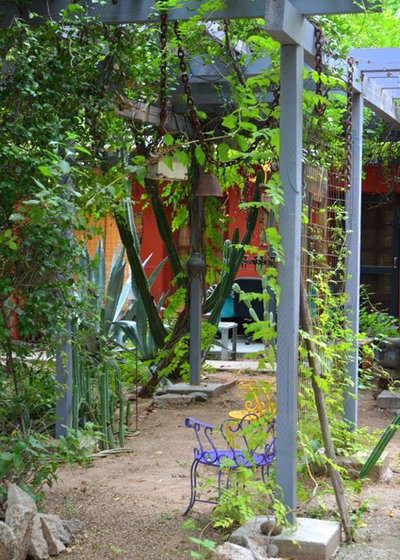
Noelle Johnson Landscape Consulting
As you enter the garden, the arbor’s gentle blue shades and the bright purple and yellow painted chairs lure you in farther to see what lies ahead.
This garden is located on what used to be two properties. Bracker bought the first property in 1993 and then bought the lot next to it three years later. She worked with an architect to unify the two plots of land, creating a courtyard on the former property line.
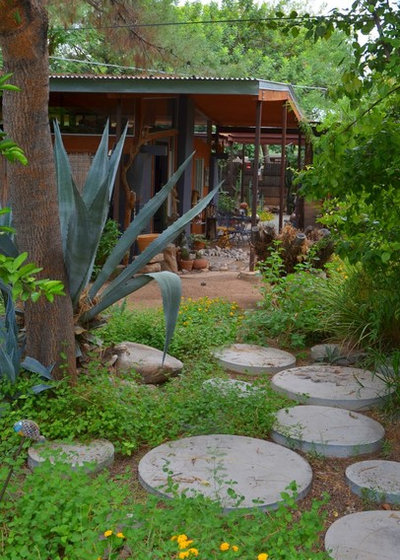
Noelle Johnson Landscape Consulting
Poured-in-place concrete steps lead through ‘New Gold’ lantana (
Lantana ‘New Gold’) toward Bracker’s studio.
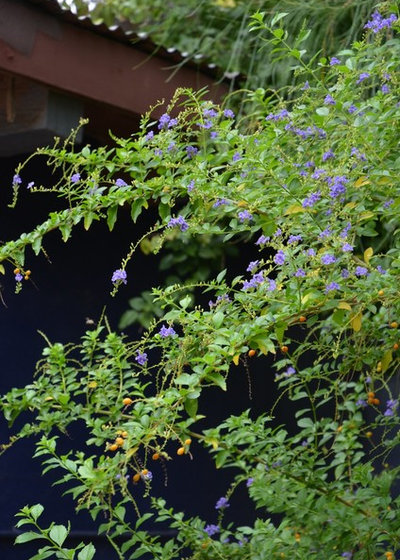
Noelle Johnson Landscape Consulting
Arching branches of golden dewdrop (
Duranta erecta) frame the walkway, while its flowers provide lovely purple color in summer and fall. This large shrub can grow more than 10 feet tall and wide and is hardy to 20 degrees Fahrenheit (minus 6.6 degrees Celsius).

Noelle Johnson Landscape Consulting
There are three original adobe buildings on the property. One of the adobe structures, originally used as a storage shed, houses Bracker’s studio. The property line ran through the middle of this adobe structure, and former residents each had one side of the building for their use. Now Bracker owns both halves. She lives in the second building and rents out the third.
Medium-size river rock and flagstone pavers flank the entry, providing a study in contrasts.
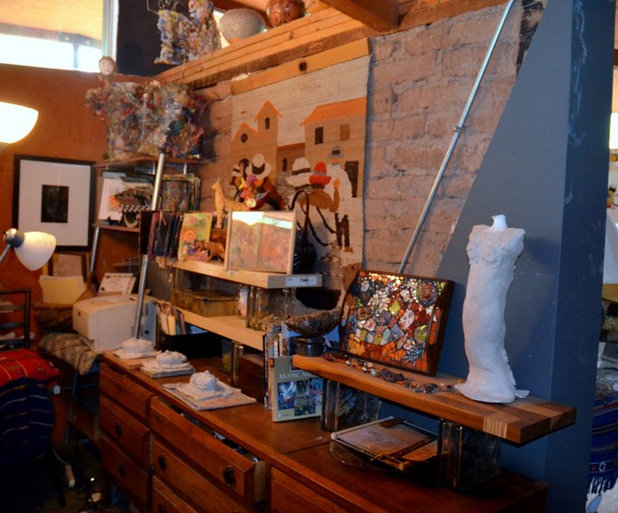
Noelle Johnson Landscape Consulting
Inside Bracker’s studio, clay sculptures in various stages of development sit against a backdrop, which includes part of the original adobe wall.
Bracker works in mediums that include clay, paper, mosaics and fibers.
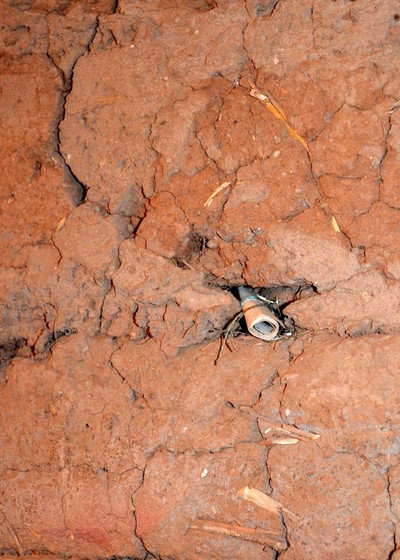
Noelle Johnson Landscape Consulting
A message from Brackert for future owners resides inside the adobe wall, where the original building materials, including straw, can be seen. Years ago, adobe was widely used throughout the Southwest. Made from mud and straw, it keeps homes cool during the heat of summer and warm in the middle of winter.
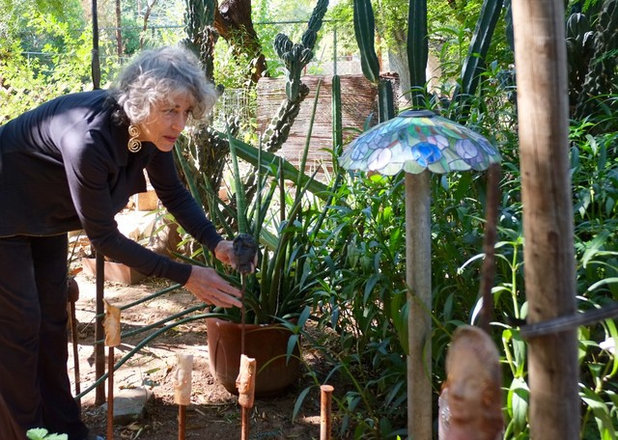
Noelle Johnson Landscape Consulting
Brackert is seen in an area of the backyard she affectionately calls “the graveyard.” Here she displays clay heads that broke off from her pieces during the firing process.

Noelle Johnson Landscape Consulting
The garden is still irrigated the same way it was in the 1930s, via concrete pipes that bring water from the canals to individual gardens.
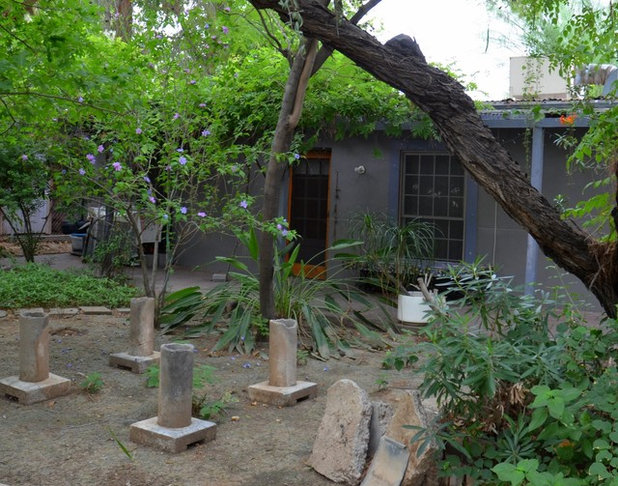
Noelle Johnson Landscape Consulting
Old concrete irrigation pipes find new purpose as garden art here. The tenant who has lived in this adobe house for 16 years gathered the old irrigation pipes and helped Brackert create this garden sculpture by mounting the pipes on raised concrete blocks.
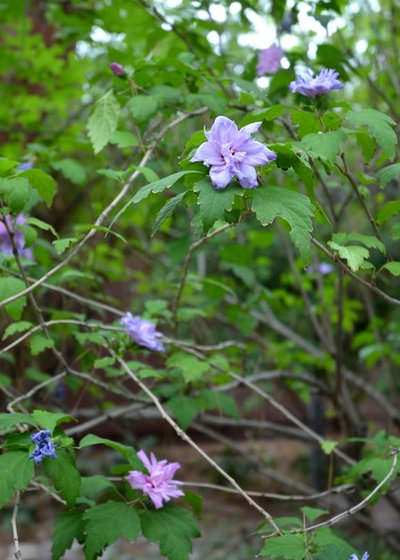
Noelle Johnson Landscape Consulting
The lavender flowers of a rose of Sharon (
Hibiscus syriacus) add gentle beauty and color to the front of the guesthouse.
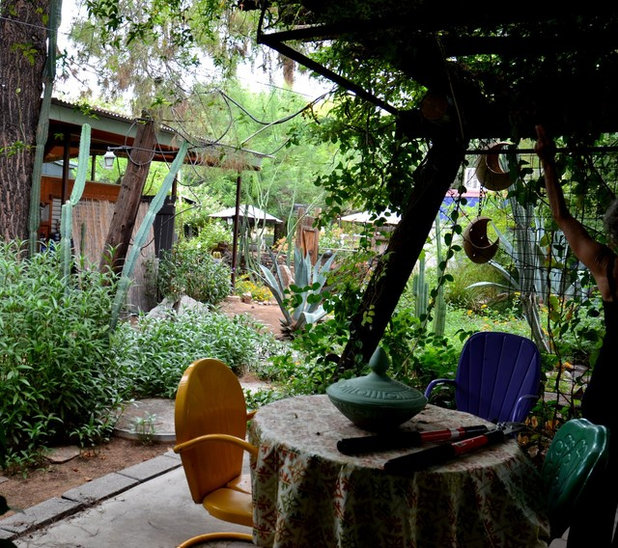
Noelle Johnson Landscape Consulting
Colorful metal lawn chairs nod to the historical origins of the property and invite the gardener to take a break from pruning to enjoy the comfort of a beautiful shady spot.

Noelle Johnson Landscape Consulting
Bracker discovered this old toy truck and car in the garden long ago. They’re now rustic garden art on an old palm tree stump. Other tree stumps on the property have found new use as outdoor tables with glass tabletops placed on them.
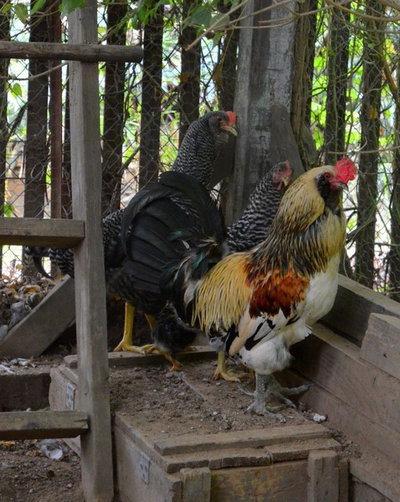
Noelle Johnson Landscape Consulting
A chicken coop enjoys a prominent spot underneath a covered pergola, where Picasso, the colorful rooster in the foreground, holds court with chickens.
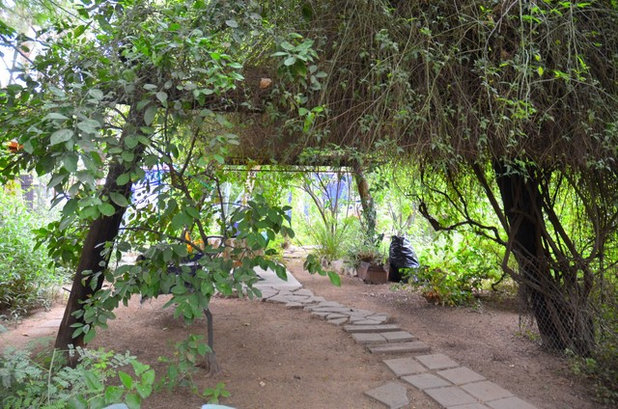
Noelle Johnson Landscape Consulting
A path of steppingstones and broken concrete, called urbanite, runs through a pergola shaded by a large Lady Banks’ rose (
Rosa banksiae). In spring, pale yellow roses fill this shady spot with their fragrance.

Noelle Johnson Landscape Consulting
Glass beads, left over from a mosaic, fill the cracks between flagstone along the garden’s pathways, catching the eye with an unexpected glimmer
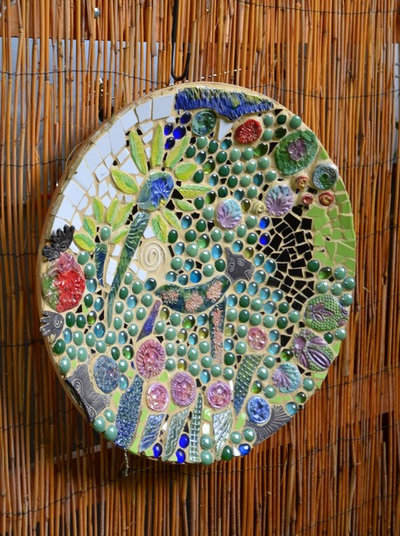
Noelle Johnson Landscape Consulting
Unique pieces of the artist’s work decorate the outdoor spaces, including this mosaic wall hanging.
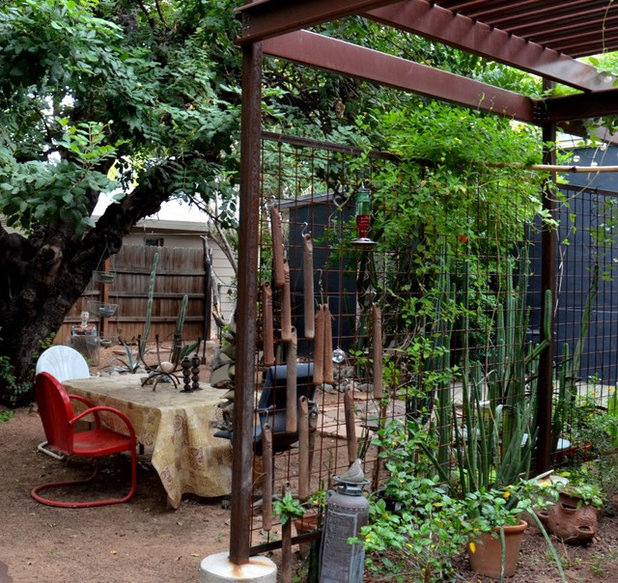
Noelle Johnson Landscape Consulting
Weights that originally helped close the old windows of the adobe home now hang from the trellis, adding a decorative element while speaking to the history of the house. A snail vine (
Vigna caracalla) grows up a rusted metal trellis.
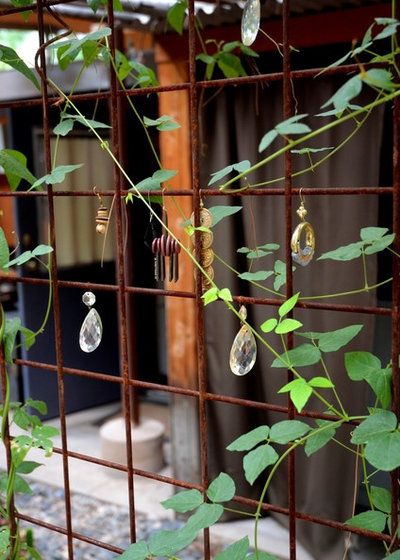
Noelle Johnson Landscape Consulting
Crystals from an old chandelier hang from a rusted metal trellis alongside the tendrils of snail vine. On sunny days the crystals produce small rainbows of color when the sun’s rays touch them. Snail vines produce light purple flowers, spring through fall, which resemble a snail shell in shape.
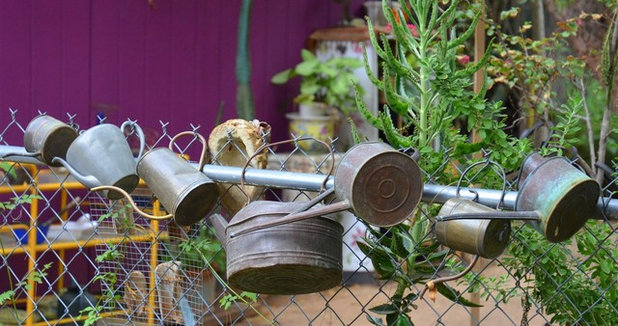
Noelle Johnson Landscape Consulting
The chain-link fence is transformed by hanging old creamers, a kettle and antique oil cans along the top. When you walk through the garden, it’s easy to see how it has influenced Bracker’s art. “The tranquility, countless stories and positive energy radiate from my garden. This is what inspires me. It is what I thrive on,” she says.
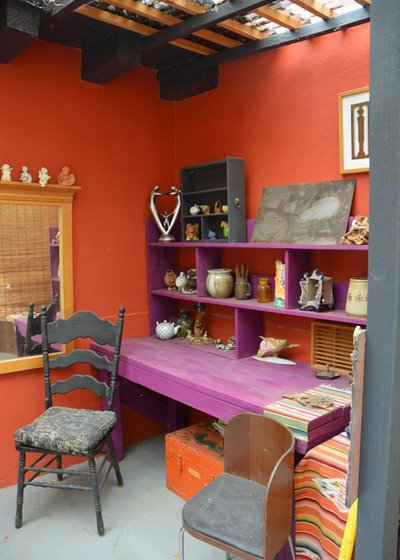
Noelle Johnson Landscape Consulting
A covered porch connected to one of the adobe buildings serves as an outdoor office space. Its brightly colored walls and desk add another dimension of color to the garden.
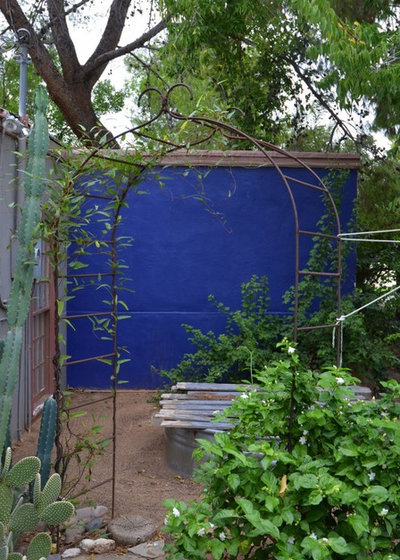
Noelle Johnson Landscape Consulting
This vibrant shade of blue contrasts with the green foliage of the bougainvillea shrub growing in front of it. A young purple lilac vine (
Hardenbergia violaceae) grows up an arbor, while the Arabian jasmine
(Jasminum sambac) shrub in the foreground has white fragrant flowers that bloom spring through fall.
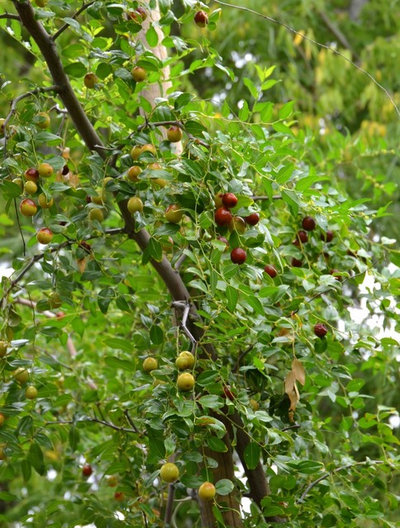
Noelle Johnson Landscape Consulting
A jujube tree
(
Ziziphus jujuba) filled with berries is seldom seen in residential gardens, although it does grow well in the Southwest’s hot, dry climate. Its berries, also referred to as Chinese dates, appear in late summer. They are edible and taste like apples.
The trees typically grow 15 feet tall but have been known to reach heights of 40 feet. Native to the Mediterranean region, they are hardy to minus 15 degrees Fahrenheit (minus 26.1 degrees Celsius).
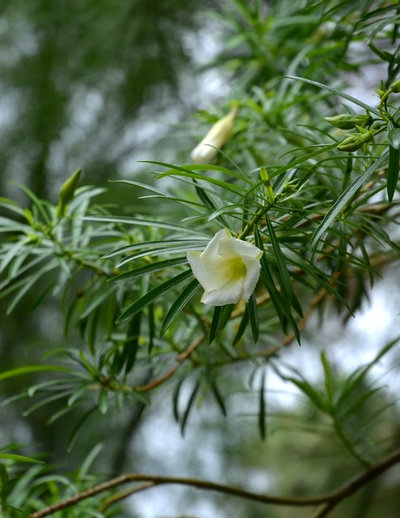
Noelle Johnson Landscape Consulting
Here is a blossom from the seldom-seen white-flowering variety of yellow oleander (
Thevetia peruviana ‘Alba’). It’s closely related to the more commonly found
Nerium oleander,
with blooms that are typically yellow or pale orange and appear spring through fall. You can grow it as a large shrub or train it into a small tree. As with its oleander cousins, all parts of this plant are poisonous.
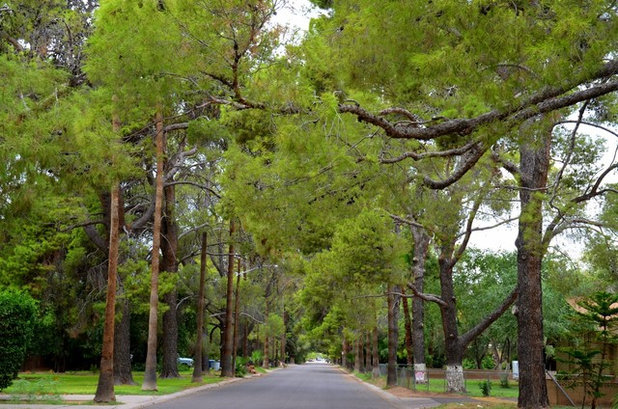
Noelle Johnson Landscape Consulting
The neighborhood of small adobe homes was established during the Great Depression. The federal government formed the Subsistence Homesteads Division in 1933, which created neighborhoods like this by buying up tracts of existing farmland. The plan was for low-income residents to plant and grow much of their own food on these home farms while also being able to hold jobs in nearby downtown areas. In all, the federal government built 34 of these farm-based communities throughout the U.S., with four in the West.
Branches of 80-year-old aleppo pine trees (
Pinus halepensis), interspersed with Mexican fan palms (
Washingtonia robusta), arch over the streets of this historical district.
Browse more inspiring gardens





